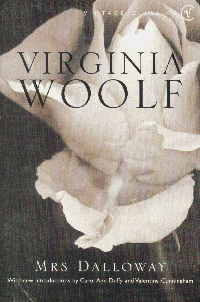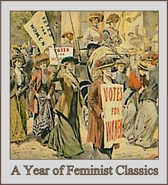
Reviewed by Lucia
Published: 1923
It's about: Everything and nothing. A single day in the life of upper middle class Mrs Dalloway, and everyone who passes in and out of the affected bubble. Woolf comments on the British class system and the effects of WWI. Think Seinfeld; a lot of things going on but not much happening.
I thought: Okay, so that description of the plot does not make this novel sound that interesting. Woolf's writing, on the other hand, is quite intoxicating. She moves through her characters' minds in long but fragmented sentences. Her use of this stream-of-consciousness style allows the reader to see both the inside and outside of characters. That is, what characters are thinking and what others think of them. Woolf's language is lively, expressive and well punctuated which supports this rambling style and stops the reader drowning in confusion.
The author's style and narrative structure (which includes no chapters or parts) allow the pieces of the novel to be spliced through the prism of a single day. However, Woolf also creates depth of character by shifting into her characters' pasts and back, often in one sentence or thought. In her diary, Woolf described this:
I should say a good deal about The Hours, &; my discovery; how I dig out beautiful caves behind my characters; I think that gives exactly what I want; humanity, humour, depth. The idea is that the caves shall connect; each comes to daylight at the present moment.
This is done very beautifully, and aids in developing the theme of the impact of war, despite it having been over for 5 years before the novel is set.
Published: 1923
It's about: Everything and nothing. A single day in the life of upper middle class Mrs Dalloway, and everyone who passes in and out of the affected bubble. Woolf comments on the British class system and the effects of WWI. Think Seinfeld; a lot of things going on but not much happening.
I thought: Okay, so that description of the plot does not make this novel sound that interesting. Woolf's writing, on the other hand, is quite intoxicating. She moves through her characters' minds in long but fragmented sentences. Her use of this stream-of-consciousness style allows the reader to see both the inside and outside of characters. That is, what characters are thinking and what others think of them. Woolf's language is lively, expressive and well punctuated which supports this rambling style and stops the reader drowning in confusion.
The author's style and narrative structure (which includes no chapters or parts) allow the pieces of the novel to be spliced through the prism of a single day. However, Woolf also creates depth of character by shifting into her characters' pasts and back, often in one sentence or thought. In her diary, Woolf described this:
I should say a good deal about The Hours, &; my discovery; how I dig out beautiful caves behind my characters; I think that gives exactly what I want; humanity, humour, depth. The idea is that the caves shall connect; each comes to daylight at the present moment.
This is done very beautifully, and aids in developing the theme of the impact of war, despite it having been over for 5 years before the novel is set.
Verdict: Stick it on the shelf.
Reading Recommendations: I really enjoyed reading Virginia Woolf's diary, particularly from 1923, while she was writing Mrs Dalloway.
Warnings: None.
Favorite excerpts: The word ‘time’ split its husk; poured its riches over him; and from his lips fell like shells, like shavings from a plane, without his making them, hard, white, imperishable, words, and flew to attach themselves to their places in an ode to time…
What I'm reading next: We Are All Made of Glue by Marina Lewycka.
Reading Recommendations: I really enjoyed reading Virginia Woolf's diary, particularly from 1923, while she was writing Mrs Dalloway.
Warnings: None.
Favorite excerpts: The word ‘time’ split its husk; poured its riches over him; and from his lips fell like shells, like shavings from a plane, without his making them, hard, white, imperishable, words, and flew to attach themselves to their places in an ode to time…
What I'm reading next: We Are All Made of Glue by Marina Lewycka.







